Call for monitoring of AG Dra by R. Galis & al.
-
Tim Lester
- Posts: 168
- Joined: Fri Apr 04, 2014 6:31 pm
- Location: Arnprior Ontario
Re: Call for monitoring of AG Dra by R. Galis & al.
My result for May 1 compared to my last two recent spectra. Also showing recent drop in Raman feature.
Tim
Tim
-
Christophe Boussin
- Posts: 172
- Joined: Sun Aug 21, 2016 6:04 pm
Re: Call for monitoring of AG Dra by R. Galis & al.
(message in English at the end)
Bonjour à tous,
Voici ma contribution au suivi de AG DRA à basse résolution (R = 500) ( http://www.astrosurf.com/aras/Aras_Data ... /AGDra.htm )
Les 2 spectres suivants ont été obtenus respectivement les 6 (JJ = 2458215.504) et 24 (JJ = 2458233.419) Avril.
Le spectre du 6 Avril à 23 h 50 TU est le résultat de 6 poses de 300 s
( format PNG dans la base ARAS : http://www.astrosurf.com/aras/Aras_Data ... 06_993.png )
( format FITS dans la base ARAS : http://www.astrosurf.com/aras/Aras_Data ... 06_993.fit )
Le spectre du 24 Avril à 21 h 48 TU est obtenu à partir de 5 poses de 300 s
( format PNG: http://www.astrosurf.com/aras/Aras_Data ... 24_909.png )
( format FITS: http://www.astrosurf.com/aras/Aras_Data ... 24_909.fit )
Les raies identifiées avec Plotspectra sont les suivantes :
L'animation ci-dessous permet de mieux apprécier l'évolution des intensités relatives des raies, en particulier les raies HeII (4686) et Hbeta (4861) entre ces 2 dates.
Bon ciel à tous,
Christophe Boussin
***********************
Hello everyone,
Here is my contribution to the monitoring of AG DRA at low resolution (R = 500) (http://www.astrosurf.com/aras/Aras_Data ... /AGDra.htm)
The two following spectra were obtained respectively the 6 (JJ = 2458215.504) and 24 (JJ = 2458233.419) April.
The spectrum of 6 April at 23 h 50 TU is the result of 6 x 300 s acquisitions
(PNG format in the ARAS base: http://www.astrosurf.com/aras/Aras_Data ... 06_993.png)
(FITS format in the base ARAS: http://) http://www.astrosurf.com/aras/Aras_Data ... 06_993.fit)
The spectrum of 24 April at 21 h 48 TU is obtained from 5 x 300 s acquisitions
(PNG format: http://www.astrosurf.com/aras/Aras_Data ... 24_909.png)
(FITS format: http://www.astrosurf.com/aras/Aras_DataBase/Symbiotics) /FitFiles/asdb_agdra_20180424_909.fit)
The lines identified with Plotspectra are the following (see at the top).
The animation at the top allows you to better appreciate the evolution of the relative intensities of the lines, especially HeII (4686) and Hbeta (4861 ) between these 2 dates.
Clear skies,
Christophe Boussin
Bonjour à tous,
Voici ma contribution au suivi de AG DRA à basse résolution (R = 500) ( http://www.astrosurf.com/aras/Aras_Data ... /AGDra.htm )
Les 2 spectres suivants ont été obtenus respectivement les 6 (JJ = 2458215.504) et 24 (JJ = 2458233.419) Avril.
Le spectre du 6 Avril à 23 h 50 TU est le résultat de 6 poses de 300 s
( format PNG dans la base ARAS : http://www.astrosurf.com/aras/Aras_Data ... 06_993.png )
( format FITS dans la base ARAS : http://www.astrosurf.com/aras/Aras_Data ... 06_993.fit )
Le spectre du 24 Avril à 21 h 48 TU est obtenu à partir de 5 poses de 300 s
( format PNG: http://www.astrosurf.com/aras/Aras_Data ... 24_909.png )
( format FITS: http://www.astrosurf.com/aras/Aras_Data ... 24_909.fit )
Les raies identifiées avec Plotspectra sont les suivantes :
L'animation ci-dessous permet de mieux apprécier l'évolution des intensités relatives des raies, en particulier les raies HeII (4686) et Hbeta (4861) entre ces 2 dates.
Bon ciel à tous,
Christophe Boussin
***********************
Hello everyone,
Here is my contribution to the monitoring of AG DRA at low resolution (R = 500) (http://www.astrosurf.com/aras/Aras_Data ... /AGDra.htm)
The two following spectra were obtained respectively the 6 (JJ = 2458215.504) and 24 (JJ = 2458233.419) April.
The spectrum of 6 April at 23 h 50 TU is the result of 6 x 300 s acquisitions
(PNG format in the ARAS base: http://www.astrosurf.com/aras/Aras_Data ... 06_993.png)
(FITS format in the base ARAS: http://) http://www.astrosurf.com/aras/Aras_Data ... 06_993.fit)
The spectrum of 24 April at 21 h 48 TU is obtained from 5 x 300 s acquisitions
(PNG format: http://www.astrosurf.com/aras/Aras_Data ... 24_909.png)
(FITS format: http://www.astrosurf.com/aras/Aras_DataBase/Symbiotics) /FitFiles/asdb_agdra_20180424_909.fit)
The lines identified with Plotspectra are the following (see at the top).
The animation at the top allows you to better appreciate the evolution of the relative intensities of the lines, especially HeII (4686) and Hbeta (4861 ) between these 2 dates.
Clear skies,
Christophe Boussin
CBO (Newton 200 F/5 / Alpy600 / Atik 314L+ / Atik Titan + Mewlon 180 F/12 / LHIRES III 2400 / Atik 460EX / Atik 314 L+) @ ARAS database
-
Francois Teyssier
- Posts: 1565
- Joined: Fri Sep 23, 2011 1:01 pm
- Location: Rouen
- Contact:
Re: Call for monitoring of AG Dra by R. Galis & al.
Status of the campaign
AAVSO: mean day values.
ARAS Spectra; blue dots
From AAVSO data, the target looks returning to quiescent state. Thus, short outburst.
Of course, we undergo the monitoring. Target: one spectrum/day at least
Thanks to all for your contribution
All the best,
François Teyssier
AAVSO: mean day values.
ARAS Spectra; blue dots
From AAVSO data, the target looks returning to quiescent state. Thus, short outburst.
Of course, we undergo the monitoring. Target: one spectrum/day at least
Thanks to all for your contribution
All the best,
François Teyssier
François Teyssier
http://www.astronomie-amateur.fr
http://www.astronomie-amateur.fr
-
Hubert Boussier
- Posts: 156
- Joined: Fri Aug 17, 2012 12:55 pm
Re: Call for monitoring of AG Dra by R. Galis & al.
Bonjour,
Ne disposant pas d'un spectro, le week-end dernier je me suis amusé à faire deux spectres en très basse résolution avec un SA200 les 24,25 et 26 avril.
J'avais un peu oublié la procédure de traitement avec un star analyseur, finalement par rapport au LISA, l'étalonnage et la réponse instrumentale ont été plus laborieux à faire et j'ai dû m'y reprendre plusieurs fois pour obtenir quelque chose qui approche le profil spectres postés sur AG Dra.
La résolution est entre 150 et 200
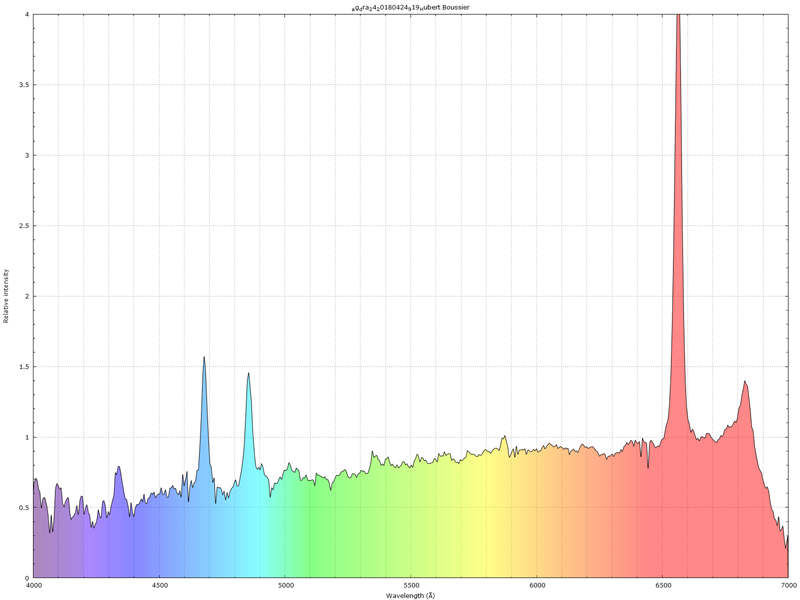
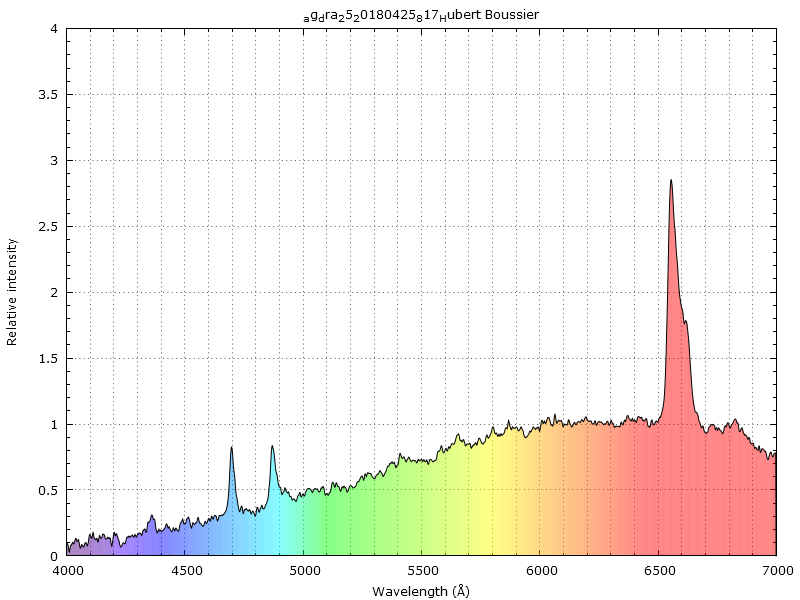
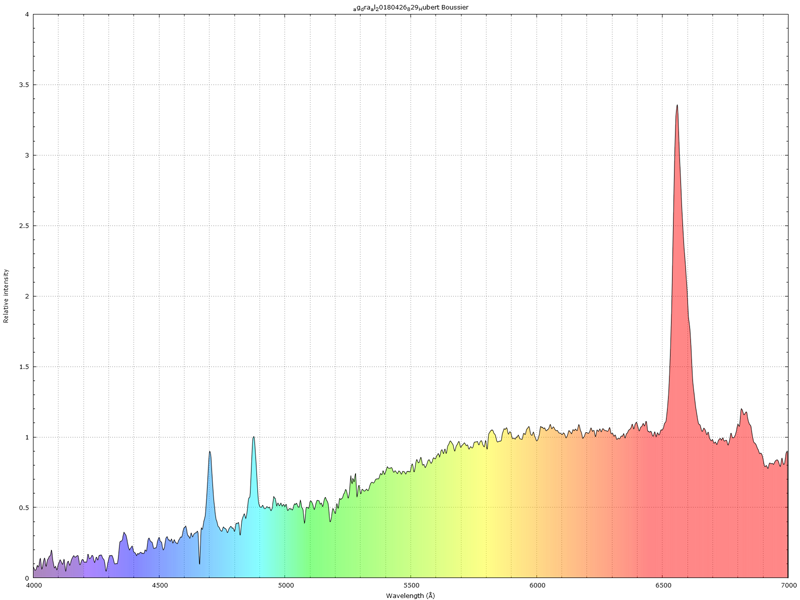
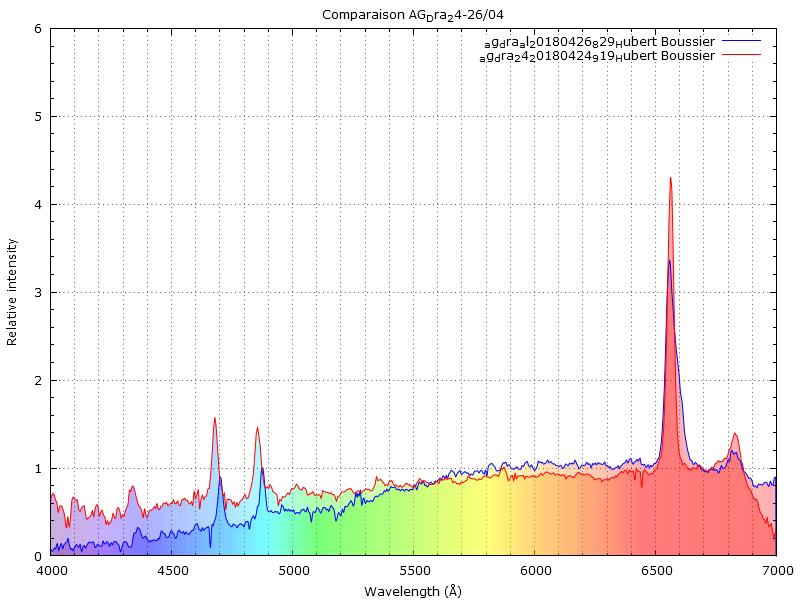
La comparaison des profils du 24 et 26 montre que le résultat de l'étalonnage n'est pas encore idéal.
Bon ciel à tous
Ne disposant pas d'un spectro, le week-end dernier je me suis amusé à faire deux spectres en très basse résolution avec un SA200 les 24,25 et 26 avril.
J'avais un peu oublié la procédure de traitement avec un star analyseur, finalement par rapport au LISA, l'étalonnage et la réponse instrumentale ont été plus laborieux à faire et j'ai dû m'y reprendre plusieurs fois pour obtenir quelque chose qui approche le profil spectres postés sur AG Dra.
La résolution est entre 150 et 200




La comparaison des profils du 24 et 26 montre que le résultat de l'étalonnage n'est pas encore idéal.
Bon ciel à tous
-
Christian Buil
- Posts: 1432
- Joined: Mon Sep 26, 2011 6:59 pm
- Contact:
Re: Call for monitoring of AG Dra by R. Galis & al.
My latest observation (1.83/05/2018) and evolution:
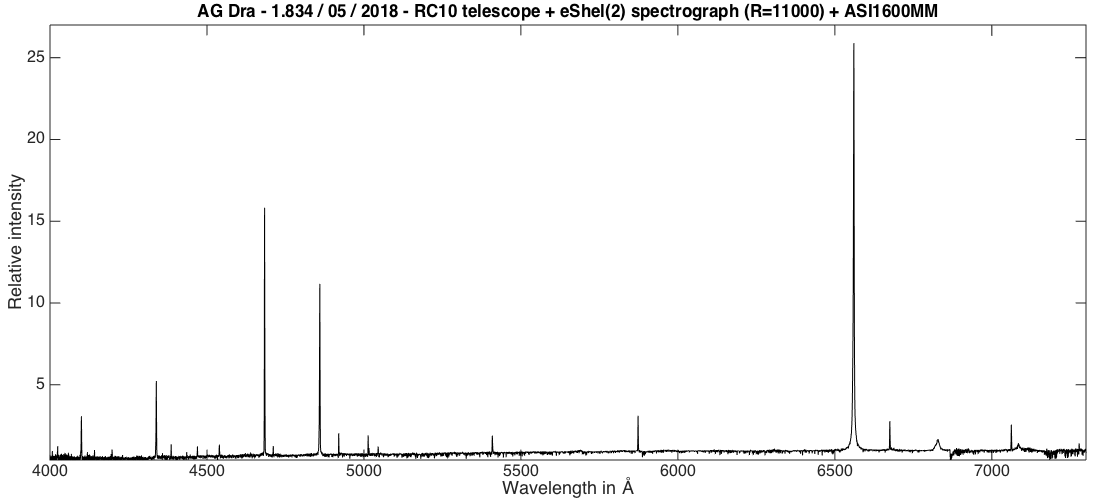
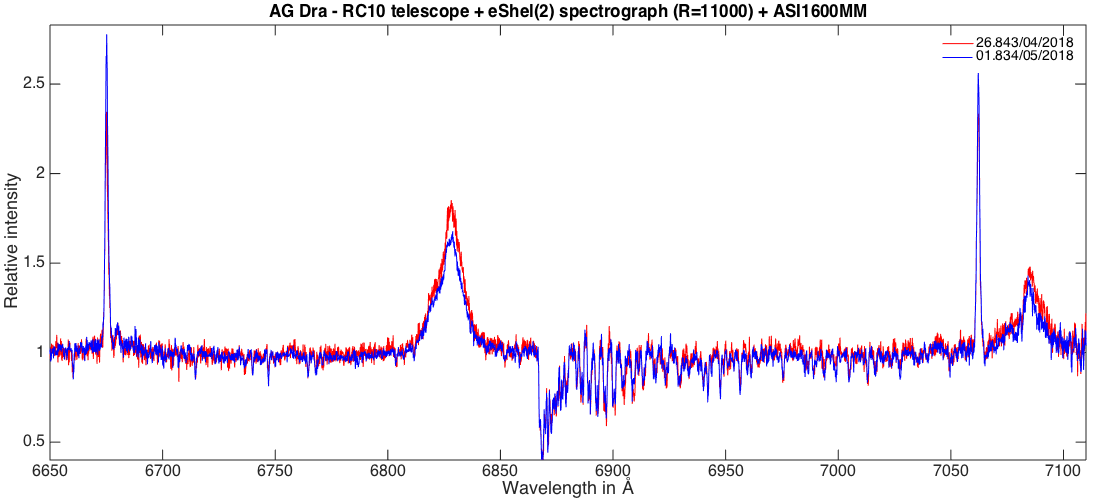
Christian B


Christian B
-
Francois Teyssier
- Posts: 1565
- Joined: Fri Sep 23, 2011 1:01 pm
- Location: Rouen
- Contact:
Re: Call for monitoring of AG Dra by R. Galis & al.
My series
raman OVI almost stable
Variations of the width of He II
Significant variations of He I lines (singlets and triplets)
He I 5876 He I 6678
Pour mémoire, behavior of Raman OVI during the short and weak 2016 outburst
in Eruptive Stars Information Letter :
François
raman OVI almost stable
Variations of the width of He II
Significant variations of He I lines (singlets and triplets)
He I 5876 He I 6678
Pour mémoire, behavior of Raman OVI during the short and weak 2016 outburst
in Eruptive Stars Information Letter :
François
François Teyssier
http://www.astronomie-amateur.fr
http://www.astronomie-amateur.fr
-
Francois Teyssier
- Posts: 1565
- Joined: Fri Sep 23, 2011 1:01 pm
- Location: Rouen
- Contact:
Re: Call for monitoring of AG Dra by R. Galis & al.
Uopdate on the campaign and current outburst
Luminosity curves since 2016 Green = V band Blue= B-V
Outburts occured on April 2016, May 2017 (weak) and May 2018 Current status Good coverage.
Message from Jaroslav: According to photometric observations of AG Draconis obtained in previous days, outburst is not over yet and the brightness continues to increase. This is very interesting behavior because of not a very steep increase in brightness. Moreover, AG Dra slowly achieves the values similar to the maximal brightness during 2016 outburst.
Spectroscopic coverage of the outburst is very good. Thanks to all which have so far been involved. Keep up the good work!
FWHM and EW of He II line All the best,
François
Luminosity curves since 2016 Green = V band Blue= B-V
Outburts occured on April 2016, May 2017 (weak) and May 2018 Current status Good coverage.
Message from Jaroslav: According to photometric observations of AG Draconis obtained in previous days, outburst is not over yet and the brightness continues to increase. This is very interesting behavior because of not a very steep increase in brightness. Moreover, AG Dra slowly achieves the values similar to the maximal brightness during 2016 outburst.
Spectroscopic coverage of the outburst is very good. Thanks to all which have so far been involved. Keep up the good work!
FWHM and EW of He II line All the best,
François
François Teyssier
http://www.astronomie-amateur.fr
http://www.astronomie-amateur.fr
-
Peter Somogyi
- Posts: 420
- Joined: Sun Jul 13, 2014 8:56 am
Re: Call for monitoring of AG Dra by R. Galis & al.
Hello,
I've managed to process all of my 3 nightly series (already available on the database) into form of EWs.
As a new addition, I've extracted Pearson-correlation on the EW-serie between 2 features - in order to see which features are changing together (important to keep in mind: not absolutely).
See the calculated correlation values table in the bottom-right corner per nightly serie (here R1 denotes Raman OVI 6825 and R2 = Raman OVI 7083): The 3 graphs are scaled to show equal time differences (a similar night window).
The first 2 series were happening at beginning 2 nights of outburst, and 04.30 is special as the Raman OVI-feature was being at lowest.
Conclusion: at different phase we can see different correlations between the feature changes (at the beginning H-alpha is correlating highly with R1, whilst on 04.30 it's near to 0). The correlation between R1 and R2 is something expected. As for HeI 7065, I am suspecting continuum determination noise might be present on it (and maybe on R2), perhaps I could work on this harder in the future.
Error estimate was brought out by measuring a nearby continuum region per-feature, and taking a whole serie's EW stddev precisely.
- Peter
I've managed to process all of my 3 nightly series (already available on the database) into form of EWs.
As a new addition, I've extracted Pearson-correlation on the EW-serie between 2 features - in order to see which features are changing together (important to keep in mind: not absolutely).
See the calculated correlation values table in the bottom-right corner per nightly serie (here R1 denotes Raman OVI 6825 and R2 = Raman OVI 7083): The 3 graphs are scaled to show equal time differences (a similar night window).
The first 2 series were happening at beginning 2 nights of outburst, and 04.30 is special as the Raman OVI-feature was being at lowest.
Conclusion: at different phase we can see different correlations between the feature changes (at the beginning H-alpha is correlating highly with R1, whilst on 04.30 it's near to 0). The correlation between R1 and R2 is something expected. As for HeI 7065, I am suspecting continuum determination noise might be present on it (and maybe on R2), perhaps I could work on this harder in the future.
Error estimate was brought out by measuring a nearby continuum region per-feature, and taking a whole serie's EW stddev precisely.
- Peter
-
Francois Teyssier
- Posts: 1565
- Joined: Fri Sep 23, 2011 1:01 pm
- Location: Rouen
- Contact:
Re: Call for monitoring of AG Dra by R. Galis & al.
An update: finally AG Dra is fading quickly at V = 9.5 (14-05)
Of course, we undergo the monitoring
François
François
François Teyssier
http://www.astronomie-amateur.fr
http://www.astronomie-amateur.fr
-
Peter Somogyi
- Posts: 420
- Joined: Sun Jul 13, 2014 8:56 am
Re: Call for monitoring of AG Dra by R. Galis & al.
Hello Benji,
The Pearson-correlation is more about a choice of convenience (here I used GDL's 'correlate' function, being at hand).
I'm wondering which error estimate method spc_ew is using (need a math formula or algorithm details).
The article "Chalabaev, A. and Maillard, J.P. 1983, A&A, 127, 279" (the eps-Aur project you mentioned referring to) focuses on analysis of some Be stars H-alpha variability, but can't find any final conclusion which formula to be used in general.
AG Dra is different in many ways (features shape are not gaussian, shortterm variance) so not sure if these theories apply here.
Cheers,
Peter
The Pearson-correlation is more about a choice of convenience (here I used GDL's 'correlate' function, being at hand).
I'm wondering which error estimate method spc_ew is using (need a math formula or algorithm details).
The article "Chalabaev, A. and Maillard, J.P. 1983, A&A, 127, 279" (the eps-Aur project you mentioned referring to) focuses on analysis of some Be stars H-alpha variability, but can't find any final conclusion which formula to be used in general.
AG Dra is different in many ways (features shape are not gaussian, shortterm variance) so not sure if these theories apply here.
Cheers,
Peter